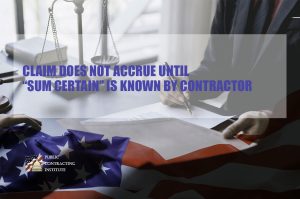The Federal Circuit recently clarified that a contractor’s claim does not accrue until the exact amount (“sum certain”) of the claim is known to the contractor. Kellogg Brown & Root Serv., Inc. v. Murphy, No. 2015-1148 (Fed. Cir. May 18, 2016), 2016 WL 2893218. This case is important because any dollar claim that fails to include a “sum certain” should be dismissed by the contracting officer and the courts.
First, a brief discussion of accrual of claims, and definition of a claim.
- The Contract Disputes Act provides that a claim “shall be submitted within 6 years after the accrual of the claim.” 41 USC § 7103(a)(4)(A).
- The FAR defines accrual of a claim as follows: “the date when all events, that fix the alleged liability of either the Government or the contractor and permit assertion of the claim, were known or should have been known. For liability to be fixed, some injury must have occurred. However, monetary damages need not have been incurred.” FAR 33.201.
- The actual accrual depends on the FAR, conditions of the contract, and the facts of the case.
- “Claim” means a written demand or written assertion …seeking as a matter of right, the payment of money in a sum certain…” FAR 2.101.
The case. Kellogg Brown & Root Services, Inc. (“KBR”) filed a claim for costs incurred by KBR for work done by its subcontractor in construction of dining facilities. The Army denied the claim, and the Armed Services Board sustained the denial, on the ground that the 6 year statute of limitations had run before KBR had filed its claim. The Federal Circuit reversed.
KBR subcontracted with a joint venture for construction work at several locations, but the contract was terminated on July 31, 2003 for non-conformance. The subcontractor disputed the termination, but continued performance until a new subcontractor began. KBR and its subcontractor disputed the termination costs, and in January 2005, agreed to determine and invoice the costs and profits incurred by the subcontractor, but only those costs KBR believed to be supportable. KBR initially submitted the subcontractor’s claim to the government (the Army), without certification, in November 2006. However, the Army refused to consider the submitted information, and directed KBR to settle the claim and then bill the government. In October 2007, KBR “sponsored” the subcontractor’s claim, but eventually withdrew it. Finally, KBR and its subcontractor agreed on a $10.4 million payment amount, and KBR filed a certified claim with the Army on May 2, 2012 for that amount—but the Army denied it entirely. Army asserted that the claim accrued on September 3, 2003, and the Armed Services Board agreed—stating that the date when the subcontractor ended work was when the claim accrued. Alternatively, the Board held that the accrual date was in January 2005, when KBR and its sub agreed to cooperate to present an invoice to the Army. Both of these dates were more than six years before KBR submitted the claim.
In considering these facts, the Court noted that fixing the date for accrual requires first that there be a claim, as defined in the Contract Disputes Act. But the actual “sum certain” required for the claim was not known in 2003 or 2005, as stated by the Armed Services Board. The Court stated that the statute of limitations period doesn’t begin to run if a claim cannot be filed because mandatory pre-claim procedures have not been completed. Here, Army required that KBR resolve all disputed costs before KBR could seek reimbursement in a formal claim, including the “sum certain” of the claim. When the costs were settled and KBR submitted the claim with a “sum certain” on November 3, 2006, it was within the six year limitations period.
There are two simple takeaways: (1) Do not submitted a dollar claim without a “sum certain” or an exact dollar amount. Do not submit “about $XX dollars.” Be exact, based on your supporting data; and (2) You may wait to submit the claim until you know the “sum certain,” even if it takes years to accurately and properly determine that amount.

